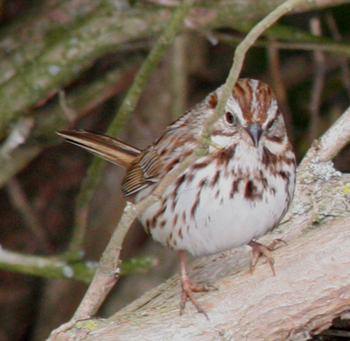Song Sparrow – Melospiza melodia
General:
The Song Sparrow has a wide geographic range, occuring over most of North America from the Aleutians to the eastern United States. It is one of the most common of America’s sparrows. There are  approximately 39 subspecies in North America and Mexico (Pyle 1997). It has a beautiful and distinctive song that is one of the most common bird calls you will hear in the summer. Like many other songbirds, the male Song Sparrow uses its song to attract mates as well as defend its territory.
approximately 39 subspecies in North America and Mexico (Pyle 1997). It has a beautiful and distinctive song that is one of the most common bird calls you will hear in the summer. Like many other songbirds, the male Song Sparrow uses its song to attract mates as well as defend its territory.
Identification tips:
The song sparrow is one of the few birds with a large geographic variation in coloration and plumage. The song sparrow is approximately 5.1/2 inches long with a conical bill. It has a brown crown, grayish face and supercilium. As can be seen the song sparrow has a brown streak that extends behind eye and a thick malar streak. It typically has a brown back with darker streaks. It has brown wings with some rust and its underparts are white with heavy dark streaks with a central breast spot. The tail is long, brown and rounded. The sexes are similar. Juveniles are similar to adult but buffier.(Patuxent Bird Identification InfoCenter). As previously mentioned, there is considerable variation in plumage across its range from dark to rusty upperparts and in bill size and shape
Habitat:
Preferred habitat for this species is brushy areas, especially in fields, along streams and the borders of woodlands. They are common in our cities and suburban areas (Audubon Society Field Guide to North American Birds).
Food:
Song sparrow diets consist of seeds, fruits, and insects.